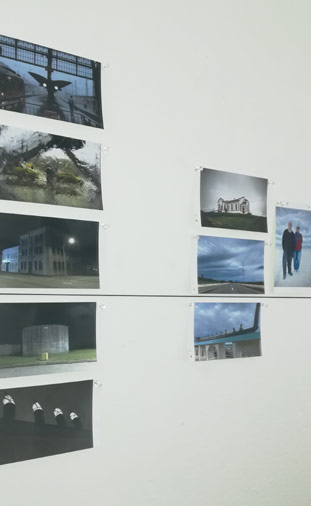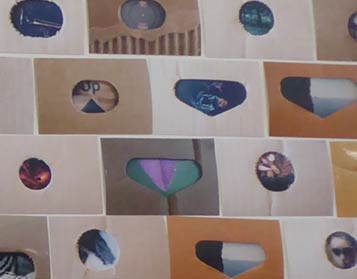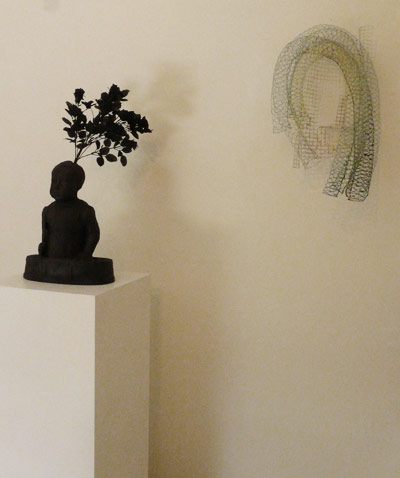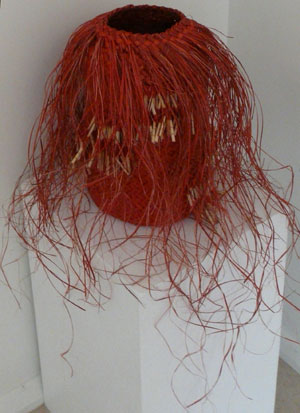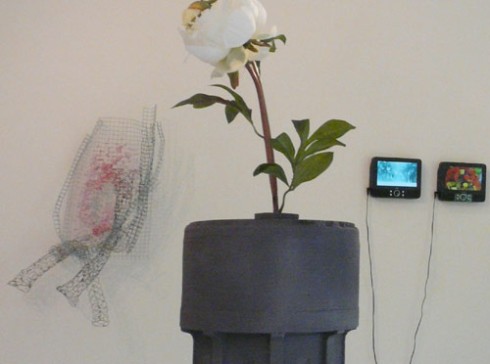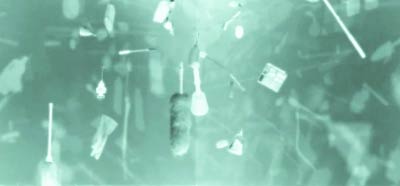NorthArt, Northcote, Auckland, Aotearoa | New Zealand
curated by Salama Moata McNamara + Sonja van Kerkhoff
Open now until 31 May 2020
Artists will be at the gallery 12-3pm,
Sat., Sun., and Monday, 12-3, 23-25th May

Left to Right: Wave, custom-made water tank by Jeff Thomson
Vitruvian Angel Man with Spirit Level by Ursula Christel. Courtesy the artist and Mokopōpaki
Pilgrimage to Mecca by Gavin Chilcott.
From the Eros and Psyche series (111) by Joanna Margaret Paul
Two untitled corrugated iron sculptures by Jeff Thomson
(foreground) New Space / Takawaenga (2020) re-purposed wooden table (dia. 118cm), 4 table legs (H: 46cm), vinyl flooring, 3mm acrylic sheets (83 x 83cm), glass chess board (38 x 38cm), ceramic tile (20 x 20cm), composite board (dia. 65cm), jute, LED lights by Ursula Christel.
New Space / Takawaenga is a conceptual assemblage inspired by geometry and the floor plan of the Dome of the Rock. It refers also to a quote by George Dei (2006) – “Inclusion is not bringing people into what already exists; it is making a new space, a better space for everyone.”
Takawaenga is a process. – Ursula Christel, 2020
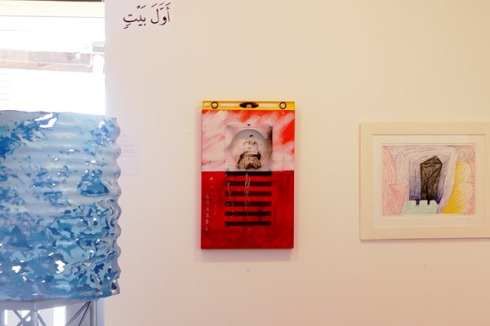
Left to Right: Wave (detail), custom-made water tank by Jeff Thomson
Vitruvian Angel Man with Spirit Level (2018) by Ursula Christel. Courtesy the artist and Mokopōpaki Acrylic, gesso, printed perspex, metal lugs, pencil, sealant on board (99 x 61cm), plastic spirit level
(6 x 61cm). Gavin Chilcott Pilgrimage to Mecca Framed pastel on paper.
Arabic text above reads: “first house (avvala baytin)” A4 text below this begins with:
“Indeed, the first House [of worship] established for humanity was that at Makkah
– blessed and a guidance for the worlds”. The Qur’an, 3:96
This is one of 5 texts in Arabic arranged around the first gallery.
More about these texts and the works in the next blog.
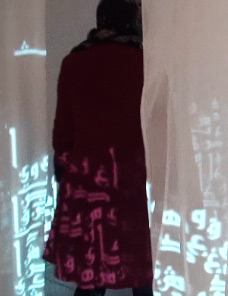
still: “Haykal Al Noor” (Bodies of Light), site specific video installation by Narjis Mirza
with the soundscape, “Pamor” by Jessika Kenney
in this short video on youtube which also shows these works:
“Light District,” framed canvas, LED lighting, by John Mulholland;
“Halg” (Throat) video from the series Sokout/Silence, by Azadeh Emadi;
“Ka aroha” (Love), gouache and ink on paper,
by Salama McNamara & Emma Paton;
“Auckland Flowers 15/03/2019,” dried flowers, soil, compost, brown paper, by Java Bentley;
“Love is Blind,” embossed braille on paper,
by Tash Nikora;
“Fabric of Humanity” cast glass with impressions of a hijab pattern based on the hijab worn by New Zealand Prime Minister Jacinda Ardern in 2019 by Layla Walter;
“Fifty-one” an installation incorporating an assemblage of painted stacked cards and texts from Rumi by Michelle Mayn.
Adibah Saad, Wellington
Azadeh Emadi, Iran / Auckland / Glasgow, Scotland
Brenda Liddiard, Auckland,
Carolyn Lye, Karetu, The Far North,
Christina Wirihana, Bay of Plenty
Emma Paton, Auckland
Fiona Lee Graham, Auckland
Gavin Chilcott, Wellington
Java Bentley, Auckland
Jeff Thomson, Helensville
Jessika Kenney, Los Angeles, U.S.
Joanna Margaret Paul, Whanganui
John Mulholland, Warkworth
Layla Walter, Auckland
Lipika Sen, Auckland
Michelle Mayn, Auckland,
Narjis Mirza, Sydney, Australia
Phil Dadson, Auckland,
Tash Nikora, Whangārei
Salama Moata McNamara, Auckland
Sen McGlinn, Kawakawa
Sonja van Kerkhoff, Kawakawa | The Hague, The Netherlands
Tash Nikora, Whangārei
Ursula Christel (Mokopōpaki), Warkworth
Some photos of the exhibition are here: artsdiary.co.nz
]]>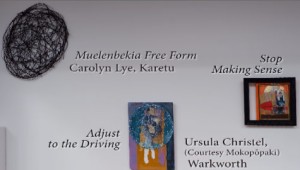
Still from the Manners of Speaking – Te Pūkoro o Tāne, Whangarei show under lockdown, 2020 12 minute video on youtube.
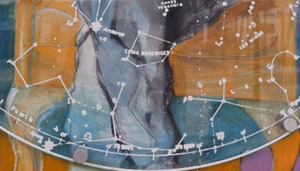
Still from the Manners of Speaking – Te Pūkoro o Tāne, Whangarei show under lockdown, 2020 12 minute video
In New Zealand things moved very fast. On Saturday evening we all heard news of a 4 step plan where we were at step 2, social distancing. Some libraries and swimming pools had closed on the Friday before. Then on Monday 23rd, when I heard of the gallery closure, we had moved to step 3 and then later in the day it was announced that New Zealand would go into lockdown, step 4, at midnight on Wednesday 25th.
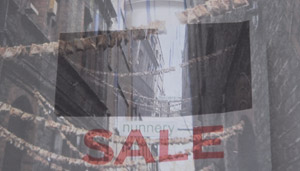
Still from the Manners of Speaking – Te Pūkoro o Tāne, Whangarei show under lockdown, 2020 12 minute video
Then Craig Denham shared his lockdown morning improvisations amongst his friends, and so we have day 4 as the soundtrack for this 12 minute video.
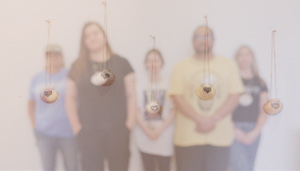
Still from the Manners of Speaking – Te Pūkoro o Tāne, Whangarei show under lockdown, 2020 12 minute video
Forced into lockdown, like Craig, I have found these weeks thought provoking – two exhibitions I co-curated are in lockdown and two other exhibitions planned for 2020 are cancelled, yet this is nothing compared to the threat of losing one’s life or livelihood.
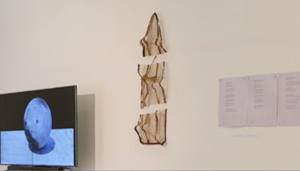
Still from the Manners of Speaking – Te Pūkoro o Tāne, Whangarei show under lockdown, 2020 12 minute video
I must go and publish the video here on youtube and then I will return to another blog later. In the meantime here is a link to a blog I wrote for a Dutch Arts Review website “CONNECTING ART IN A TIME OF CRISIS: New Zealand –The Netherlands.”
]]>Geoff Wilson Gallery, NorthTec Campus, Whangārei, Aotearoa
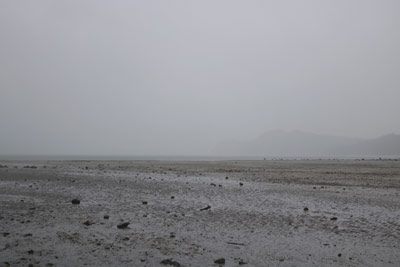
Ghosts photographic print by Ashleigh Taupaki. 42.0 x 59.4 cm
I te huringa kōmuri, e haramā te whenua i te kēhua
On looking back, the land was covered white with ghosts
Hauraki proverb
Over 50 works in diverse media on themes of proverbs and sayings by artists based in Aotearoa and beyond, curated by Sonja van Kerkhoff with 3rd year NorthTec year students.
Artists
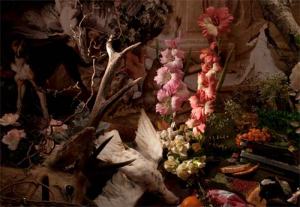
Animal Picnic, Archival Lambda print, 1 out of edition of 3
by Andrea Gardner. 82 x 57 cm
(click for a larger view)
Andrea Gardner, Whanganui
Ashleigh Taupaki, Auckland
Brenda Liddiard, Auckland
Brit Bunkley, Whanganui
Carolyn Lye,
Karetu, The Far North
Catrina Sutter,
Russell / Kororāreka
Chiara Rubino,
Matera, Italy
Cle Tukuitonga, Otangaroa, The Far North
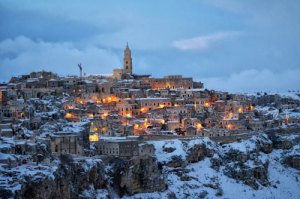
Chiara Rubino, photographic print, 28 x 21 cm
Buona e’ la neve che a suo tempo viene
Good is the snow that comes in its time
Chiara Rubino photographs her home city, Matera, a UNESCO heritage city in southern Italy.
London, UK
Giacomo Silvano,
Irsina, Italy
Hilda Simetin, Auckland
Jacqueline Wassen, Maastricht,
The Netherlands
Jamie Larnach, Auckland
Jarred Taylor + others, Whangārei
Jeff Thomson, Helensville
Joas Nebe, Germany
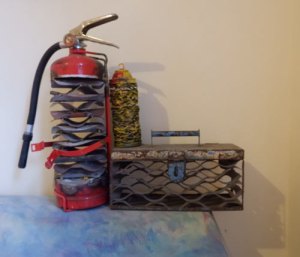
Jeff Thomson, 3 piece assemblage
“There’s No Iron So Hard That Rust Won’t Fret It;
and There’s No Cloth So Fine That Moths Won’t Eat It.” Scottish Proverb
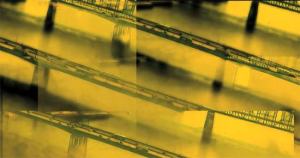
Joas Nebe, still, The Shareholder´s Room, video, 3 min 45 sec
Man steigt nicht zweimal in denselben Fluß
You Cannot Step Into the Same River Twice
Heraclitus (c. 535 – c. 475 BC, Greece)
John Mulholland, Warkworth
Maartje Zandboer, The Hague,
The Netherlands
Naomi Roche, Waikato
Lipika Sen & Prabhjyot Majithia, Auckland
Peter Scott, Kerikeri
Piet Nieuwland, Whangārei
Robert Brown, Whangaparaoa
Sam Melser, Auckland
Sonja van Kerkhoff, Kawakawa
Tash Nikora, Whangārei
Tracy Singer, Auckland
Ursula Christel (Mokopōpaki), Warkworth
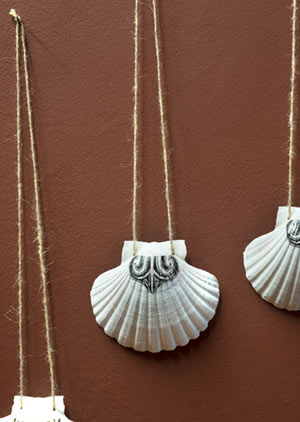
Yllwbro Te Ara ki Rangihoua: The Way to Rangihoua, 2018 Scallop shells, brown string, moko adhesive.
Courtesy the artists and Mokopōpaki, Auckland
Geoff Wilson Gallery, NorthTec, Gate 3, 51 Raumanga Valley Road, Whangarei
Opening 4-7p.m., 21 Feb 2020
open: 12 – 4 p.m. Wednesdays – Fridays,
and by appointment.
facebook event page for this exhibition
]]>The self-deprecating title, also a witty allusion to pop art (Roy Lichtenstein’s paintings of cartoons with speech bubbles were often onomatopoeiatic and pop art itself re-presented the ordinary and contemporary). The exhibition was a photographic project that translated the snap-shotted individual instant into the multi-medial.
It was also a participatory project: anyone with a smart phone and $2 was invited to add one of their snaps to the walls. A horizon line served as a visual guide but also added a level of complexity to the experience of Snap, Crackle Pop-up. Images above, below or across the line invited the viewer to read meanings into the placement and juxtapositionings – akin to how (despite our belief in our individualisms) each of us, is affected by our society.
The ShutterRoom is hardly a pop-up gallery having a stable following for over five years in its central Whangarei space directly across from the city public library. This proximity was part of the aesthetic experience created by The Shutter Room Collective curators, Heath, Leigh & Ken.
The first instruction I was given was to take 30-odd steps towards the library to use the wifi access there to download the app required to print out my snapshot. Back in the gallery, the snapshot was printed and I was given pins to place it anywhere on the walls. Feeling rebellious, I pinned my image across the line then I counted only one cat and several baby photos in the 50 or more images. The open curation approach had an element of risk, especially where a broad public could easily walk in, but the eye height line appears to have encouraged a self displine in regards to the content and thoughtfulness in the total composition. ]]>You are instructed to choose an image and then to find it peeping out of one of the orfices of the stacks of 80 or more banana boxes in the gallery space. The title of the show refers to the continually changing configurations created by the visitors. While the photographic images by the artists showing snippits of their lives are framed to be looked at, pondered over or recognized, the frames obscure more than they reveal and the installation of nooks and crannies and towers is not only random but temporary. By removing both frame and label this project blurs authorship which often in the art world is an important part of the artwork’s value or reception. Visitors place and re-position the boxes and so affect the way the images or the boxes are read by the participants themselves as well as later visitor-participants. Not only the medium is blurred (installation, performance or an opportunity to rearrange) but also the usual separation between the art object and the gallery visitor. The risk is that the next visitor, expecting their art gallery experience to be about reading a static arrangement, sees nothing resembling ‘art.’ But like many social practice art projects which blur the borders between life and art, a clear context – here in the form of instructions to find the image – helps the viewer to step inside the magic circle and once engaged in the game there’s space for contemplation.
The banana box itself is a migrant entering the country on the back of trade as well as being the ubiquitous storage system. But I am being too serious, because this exhibition oozes with joy and lightheartedness. The images are light or delicate with not a trace of angst and none of the boxes are overly battered. There is an out of the box sense of exploration and play that blurs the lines of “object making, performance, political activism, community organizing, environmentalism and investigative journalism, creating a deeply participatory art” [1] experience. In another sense the box functions as an enabler of alterity (to reference Spivak whose 1997 Documenta lecture made a huge impact on me), a way of exhibiting the photographic in a divergent space – from the inside of the migrant banana box, with whatever baggage it might have that distinguishes it from a gallery wall.
Footnote: Outside the Citadel, Social Practice Art Is Intended to Nurture, New York Times, 2013
“Reconfiguring” by Sarah Kippenberger and Chris Schreuder,
29 March – 27 April 2019,
The Shutter Room, 9 Rust Avenue, Whangārei
Opposite the public library main door
Wed – Fri 12-4pm, Sat 10-2pm
The Shutter Room Facebook page
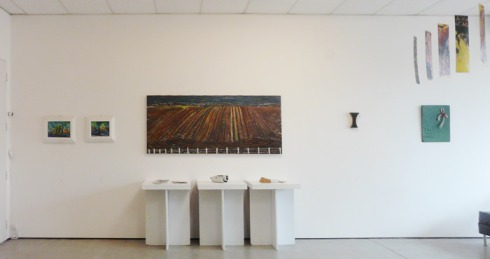
Left to Right: “HearSay,” soundpiece, 2018, recording of a generated audio work, by Jonathan Reus.
Two paintings by Roger Morris. “Trope,” 2018, oil on canvas, 190 x 75 cm by Raewyn Turner and ceramic works by Jess Paraone. Two small works by Sonja van Kerkhoff. “Pandora’s Box” 5 piece suspended double side painting by Alexis Hunter.
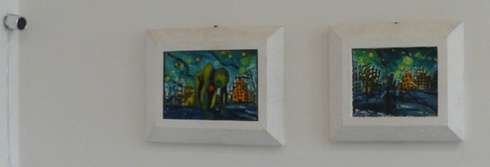
Left to Right: “HearSay,” soundpiece, 2018, recording of a generated audio work, by Jonathan Reus.
“Enduring Freedom” and “‘Axis’ ONE” Oils on board by Roger Morris.
“HearSay,” was created by an algorithm which recombined recordings of news broadcasts from CNN, MSNBC and the BBC of an underground slave trade emerging in Libya as reported by CNN in October 2017. The story of the slave trade in Libya was reported through rumors and collections of stories by migrants stranded in local detention camps. This work highlights the problem of news organisations presenting images of truth when these are based on fragmented and subjective testimony.
This is one of several algorithmically generated sound works by Jonathan Reus, which explore the aesthetic elements of news broadcasts, by contrasting the authoritative voices of news reporters to witnesses, foley sounds, and background music used to enhance drama in the macro and micro sonic. A first sketch of this work was created during the Transmarcations work session in Brussels, 2017 organized by http://constantvzw.org

“Binary investigations,” 2 piece glazed ceramic, “Binary investigations,” glazed ceramic, “Liminal,” ceramic, “Binary with foundation,” partially glazed ceramic by Jess Paraone (Ngāti Kawau, Kaitangata).
The rows of zeros and ones stamped into the slab-like “Binary series” works by Jess Paraone (Ngāti Kawau, Kaitangata) play off against expressionistic abstract colours and glazes. These numbers can be read simultaneously as abstract element and as symbol for the human or mark of the human made machine. The central piece, from the “Liminal” series is a rolled slab of black dyed raku clay and porcelain clay – materials with very different properties. The contrasting materiality (rough vs smooth, brittle vs elastic) and colours invite multiple readings on the theme of oppositions, compatibility, and diversity.
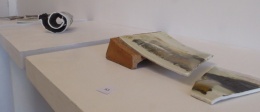
“Liminal,” slip cast porcelain slab + raku clay coloured with black stain, fired to 1260 degrees celcius, “Binary with foundation,” glazed porcelain and brick by Jess Paraone. Click for a larger view.
Gallery 1 | Gallery 2]]>
 The Hikurangi Art Station
The Hikurangi Art StationHikurangi, Northland
3 – 31 March
Opening on 3 March, 5 p.m. Music and potluck (bring some food or drink)
Open Tues-Sunday, 10-4 pm
Curated by Virginia Guy + Sonja van Kerkhoff
Nearly everyone has worn a T-shirt and most have outgrown one. T-shirts are often used as a form of branding, advertising or the making of a statement. T-shirt as a sculpture, a painting, a poem or as a second chance? Come view an installation of lines of hanging t-shirts in the newly opened, artist-run space, The Hikurangi Art Station along with a show of prints in the other half of the gallery.

Detail of Elephants for Peace by Elaine Arkell, London, U.K.
Some artists have responded to the T-shirt as medium such as Elaine Arkell’s “Elephants for Peace” series made for a the Ganesha art exhibition held on the streets on both sides of the border on the island of Cyprus. She made these T-shirts in 2011 to be worn by artists involved in performances on the streets. Another submission “Forget Us Not” are the work shirts of Alison and Ursula in their rural Wales gardening business which specializes in garden care for the often forgotten, the elderly.
Jason Ratahi’s submission is a statement of intent. Tīmatanga Kaitiaki (Protected or mindful beginning, start or introduction) is a T-shirt of slogans, in Māori and New Zealand English. Other artists have taken T-shirts and used them as a medium for re-shaping or re-making.
Jacqueline Wassen’s work uses the T-shirt as subject matter: she has created a paper shirt to be burned as an offering where what remains is a video documentation. More about this show is here
]]>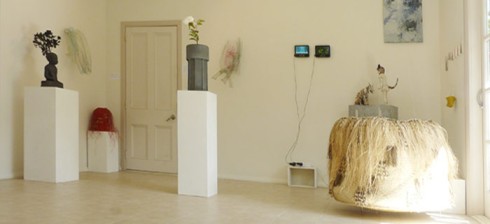
Left to Right: St Cyricus, plastic, artificial flowers and Epoxy, 40 x 15 x 60 cm by Brit Bunkley; Netting, wire and acrylic, by Michelle Backhouse; Pouhine (red basket form), harakeke (flax), muka (flax fibre), commercial dyes. Raranga + whatu (Māori weaving techniques) by Adrienne Spratt; Lake Alice Water-tower, plastic, paint and artificial flowers, 60 x 12 x 12 cm, by Brit Bunkley; Into the pink, wire and acrylic, by Michelle Backhouse; Cleaning the Air, 43 sec video + Daily Dishes, 7 min 11 sec video by Pietertje van Splunter; Oil on canvas by Edward Walton; From the War / No War series, six laser print on card reliefs (obliquely on the wall) by Hohepa; Kete Pingao, 20 x 10 cm, woven basket by Brenda Tuuta; Herenga rahi (Big connections/confinement), harakeke, muka, tanekaha bark and paru dyes. Raranga, whatu (Māori weaving techniques, suspended basket) by Adrienne Spratt.
Bunkley saw this statue in the Los Angeles Getty museum (view this statue) and was intrigued by the idea of a saint being a child. The story goes that in about 200-300 AD, that the child while being held by the governor (while the child’s mother, Saint Julitta, was on trial) the child stated that he was also a Christian and bit the governor. For this act of defiance the child was killed. Other stories tell of him being brutally tortured. The Renaissance artist incorporated symbols of sainthood such as the palm and laurel branches, and the cut off body suggests that he might be in a cauldron. The recasting of this in dark grey plastic with the addition of artificial flowers, makes the work an enigma because both aspects of social history (the religious and the art context of the statue at present) are simultaneously referenced and distanced.
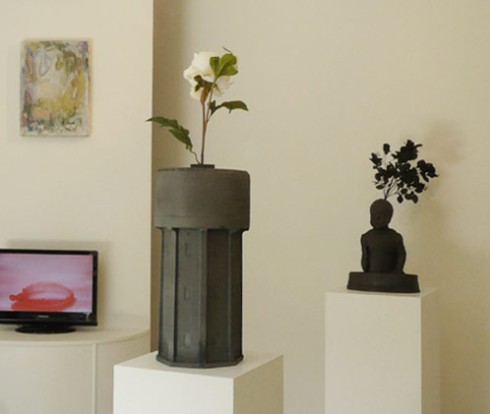
L to R: Een Rode Citroen (A red lemon), 2015, 9 min 53 sec., video + soundscape by Anne Wellmer; Oil on canvas by Edward Walton; Lake Alice Water-tower + St Cyricus by Brit Bunkley.
The flower could be a sign that nature always endures, always has some measure of self-sufficency, while the static cultural innate object gains or loses meaning if its function is lost. However in foregrounding the materiality of these sculptures, such as details in the greyer than grey facades, he reminds us that this is still artifice, it is still plastic, and in the end this is a sculpture of oppositions that forces us to take our own stance.
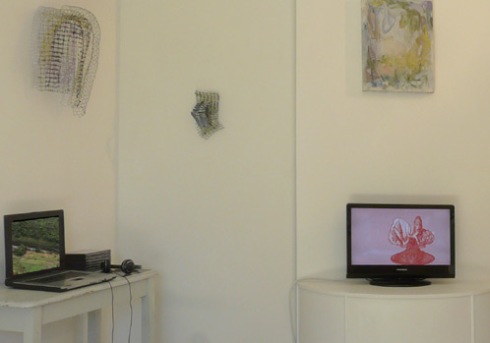
Left to Right: Kāinga a roto (Home Within), suite of 5 videos (on laptop) by Sonja van Kerkhoff, Adumbrate No. 2, 2014, wire netting + Untitled, 2017, wire netting and building paper by Michelle Backhouse; Oil on canvas by Edward Walton; Een Rode Citroen (A red lemon), 2015, animation, 9′ 53” by Anne Wellmer. Soundtrack: Anne Wellmer. Drawings: Geerten Ten Bosch. Animation: Harriët van Reek. Text excerpt from The Writing Notebooks (edited in English by Susan Sellers) by Hélène Cixous. Voice: Stephie Büttrich-Kolman.

Still from Vox Sanguinis (Voice of the blood), 1’53”. Video and soundtrack: Anne Wellmer. Video and soundtrack: Anne Wellmer. Camera: Florian Cramer. Voice: Cora Schmeiser. Music: “O rubor sanguinis” by Hildegard of Bingen. Trumpet: Heimo Wallner. Silent performer and stage design: Geerten Ten Bosch
Another video Vox Sanguinis (Voice of the blood), was a teaser for the music theater performance by Cora Schmeiser with new compositions inspired by Hildegard of Bingen (1098-1179) by 4 Dutch composers: Giuliano Bracci, Kate Moore, Lukas Simonis, Boudewijn Tarenskeen and Aliona Yurtsevich. The sound design and live electronics were by Anne Wellmer. Vox Sanguinis toured to four cities in the Netherlands in 2015.
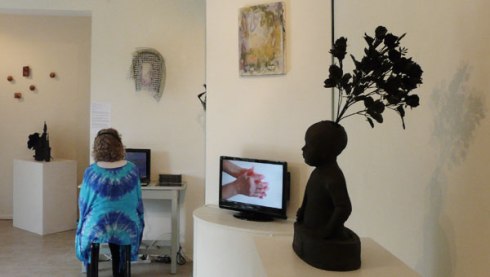
Left to Right: Warm Memories, emulsion on five suspended teabags by Martje Zandboer; The Happiest place on earth, plastic, paint and artifical flowers, 55 x 45 x 10 cm, by Brit Bunkley; Kāinga a roto (Home Within), videos (on laptop) by Sonja van Kerkhoff; Adumbrate No. 2, 2014, wire netting + Untitled, 2017, wire netting and building paper by Michelle Backhouse; Oil on canvas by Edward Walton; Transfusionen (Transfusions), 2015, video with sound, 2′ 43” by Anne Wellmer. Sound: Anne Wellmer. Hands: Geerten Ten Bosch. Voice: Cora Schmeiser. Music fragment from BLAST (2015) by Lukas Simonis. Text fragment from ‘Della Religione Christiana’ by Marsilio Ficino (1433-1499), first published in Italian in 1568. This German translation was published in ‘Das Blut: Symbolik und Magie’ (Blood: Symbolism and Magic) (2004) by Piero Camporesi; St Cyricus 3D plastic print sculpture by Brit Bunkley.
The sounds from these three videos were the soundscape of this show unless one put on headphones to listen to two of the other videos in the exhibition. Under two spatial abstractions of wire by Michelle Backhouse was the suite of videos, Kāinga a roto (Home Within), by Sonja van Kerkhoff (More >>) and around the corner was the 29 minute video, Et in Arcadia Ego by Channa Boon.

Left to Right: Et in Arcadia Ego, 29 min video by Channa Boon; Love of the other, 10 cm diameter, print on aluminium by Sonja van Kerkhoff; Muka and taniko kete, harakeke muka, tanekaha bark + paru dyes. Whatu and taniko (Māori fibre and weaving techniques) by Adrienne Spratt; What kind of Idea, print on dubond by Sonja van Kerkhoff (More >>).
Virgil’s phrase ‘Et in Arcadia Ego’ is also the title of a famous painting (1638) by Nicolas Poussin. The painting shows a group of shepherds who discover the phrase on a tomb, and so become aware of the existence of death in their Arcadian existence. This gives them the capacity to reflect and thus develop self-awareness. In this video, Boon connects this loss of innocence of the Arcadian shepherd – signifying an ideal world that is destroyed forever – with the present and past of the former Soviet Union. Hence, the phrase becomes a reference to the ideal world that Communism aimed to bring about in this region and the nostalgia that it still invokes.
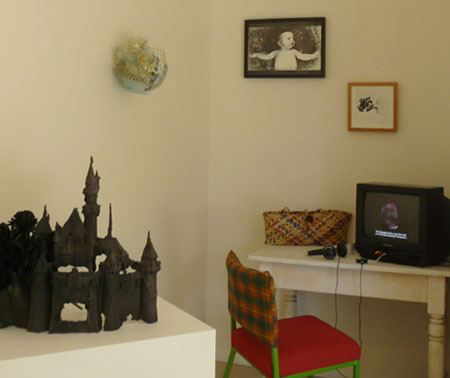
Left to Right: The Happiest place on earth, plastic, paint and artifical flowers by Brit Bunkley; Enclosure No. 1 wire netting + paperpulp by Michelle Backhouse; The Image (The spectacle is mesmeric in order to be successful), silkscreen print and mixed media (More >>) + Where change is barely visible, 2008, laser print by Sonja van Kerkhoff; Kete Whakairo (on table), dyed flax basket by Brenda Tuuta; Et in Arcadia Ego, 29 min video by Channa Boon.
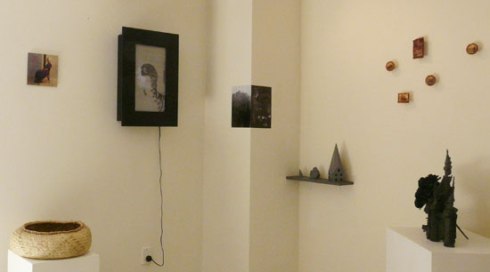
Left to Right: Mauri, harakeke, raranga (Māori weaving techniques) by Adrienne Spratt; Josephine’s Mother, print on aluminium, acrylic and varnish by Sonja van Kerkhoff (More >>); Bird of Prey, mixed media video loop by Sanne Maes; Untitled + Dark Entries, black and white photographs + The Speed of Dark, models on a shelf by Thom Vink; Warm Memories, photographic emulsion on teabags + magnets by Martje Zandboer and The Happiest place on earth, plastic, paint and artifical flowers, 55 x 45 x 10 cm, by Brit Bunkley (More >>).
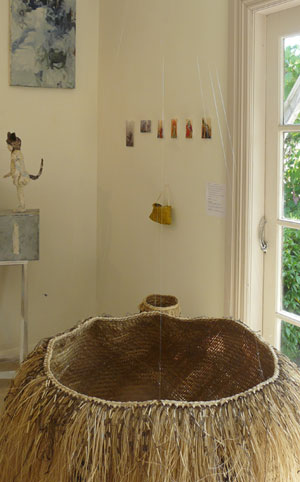
Left to Right: detail of Girl with Iberian Lynx by Michelle Backhouse; Oil on canvas by Edward Walton; From the War / No War series, six laser print on card reliefs, each is 10 x 15 x 2 cm, by Hohepa; Poutama (Step pattern), cylinder shaped basket + Herenga rahi (Big connections/confinement), harakeke, muka, tanekaha bark and paru dyes. Raranga, whatu (Māori weaving techniques) by Adrienne Spratt.
On the other side of the gallery space are two more woven vessels by Adrienne Spratt. The enormous basket sways from numerous lines. Its title refers to both connection and enclosure.
On the adjacent wall a frieze relief of reproductions of paintings from Hohepa’s War / No War series uses Maori cultural symbols as commentary issues of the day. Below this is a small purse-like open pingao (a New Zealand natuve yellow grass) basket by Brenda Tuuta.
In another corner lines flow out from the red basket, Pouhine by Adrienne Spratt, which blur its contours. The title refers to the pattern woven into the sides.
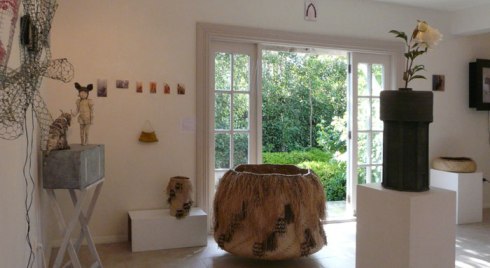
Left ot Right: Detail of Into the Pink, wire and paper pulp + Girl with Iberian Lynx by Michelle Backhouse; From the War / No War series, six laser print on card reliefs, each is 10 x 15 cm, by Hohepa; Kete Pingao, 20 x 10 cm, woven basket by Brenda Tuuta; Poutama (Step pattern), cylinder shaped basket + Herenga rahi (Big connections/confinement), harakeke, muka, tanekaha bark and paru dyes. Raranga, whatu (Māori weaving techniques) by Adrienne Spratt, Paewae (Threshold), aluminium print (above doorway) by Sonja van Kerkhoff; Lake Alice Water-tower, plastic sculpture by Brit Bunkley; Josephine’s Mother, print on aluminium, acrylic and varnish by Sonja van Kerkhoff; Mauri (essence/spirit), harakeke, raranga (Māori weaving techniques) by Adrienne Spratt; Detail of Bird of Prey, mixed media video loop by Sanne Maes.
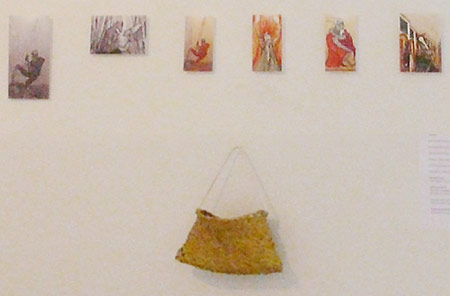
Left to Right: From the War / No War series: Warrior with Taiaha, Patu-paiarehe lovers, black and white laser prints on card, Warrior with Taiaha, Mākutu, No more war with Taiaha laid down, Rangatahi, colour laser prints on card, each piece approx. 10 x 15 x 2 cm, by Hohepa; Kete Pingao, 20 x 10 cm, woven basket by Brenda Tuuta.
The video Cleaning the Air is actually a recording of a mobile sculpture which animates various household cleaning objects while in the video, Daily Dishes, the mundane chore of doing the dishes is turned into an animation of colour and pattern. Pietertje van Splunter’s videos are like a poetics on the mundane: housework. Her brooms seem animated by an unearthly force and the constant stacking of the differing tribes of kitchen utensils suggests a game with secret rules. In using humour with the overkill her videos are reminders that the everyday domestic, is also a microcosm of the amusing, perhaps necessary banality of habit while Michelle Backhouse’s sculptures use seemingly banal materials, building paper, netting or house paint to create ethereal protusions.]]>
The Speed of Dark, 3 objects on a shelf by Thom Vink + The Happiest place on earth, 3D print by Brit Bunkley” width=”300″ height=”463″ class=”size-full wp-image-1581″ /> Left to Right: Photograph by Thom Vink
The Speed of Dark, 3 objects on a shelf by Thom Vink + The Happiest place on earth, 3D print by Brit Bunkley
This is one of three 3D printed architectural and cultural models from scans of actual structures combined with a bunch of artifical flowers by Brit Bunkley in this exhibition.
“The Happiest place on earth” is based the Sleeping Beauty Castle at the centre of Disneyland in California, which in turn is based on the late-19th century Neuschwanstein Castle in Bavaria, Germany.
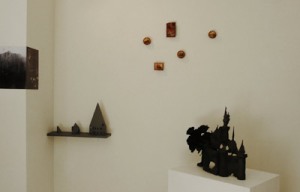
Left to Right: Photograph + The Speed of Dark,
3 objects on a shelf by Thom Vink;
Warm Memories by Martje Zandboer;
The Happiest place on earth, PLA, paint and artifical flowers, 55 x 45 x 10 cm, by Brit Bunkley
Cast in a dark grey plastic as a facade with ragged edges and stuffed with a bunch of black flowers it comes across as an errie romantic ruin in miniature.
Bunkley’s series of abject sculptures are works about nature vs culture, nature out of culture and reminders of the darker side of the transcience of culture. More >>
“Peaceable Kingdom” made with Andrea Gardner is a 2017 suite of sculptures on show in the
Auckland Botanical Gardens until February 2018.
13 New Zealand and Hague Based artists in The Poetic Condition show until 10 Dec 2017 at the BackWal Gallery, 99 Atkinson Ave, Otaki. 12 Nov blog | Exhibition info | BritBunkley.com
]]>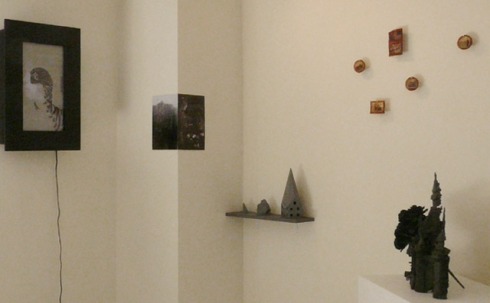
Left to Right: works by Sanne Maes (video + drawing) + Thom Vink (photographs + model on shelf), Martje Zandboer (emulsion on teabags), Brit Bunkley (PLA plastic and Fiberglas reinforced resin and artificial flowers)
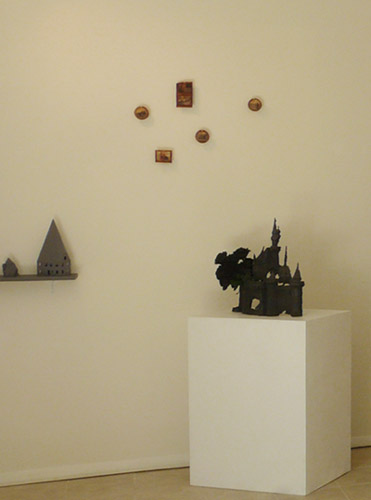
Left to Right: Detail of Thom Vink’s model on shelf, Martje Zandboer (emulsion on teabags), “The Happiest Place on Earth” by Brit Bunkley (PLA plastic and fiberglas reinforced resin and artificial flowers).
This Dutch colony was formed by the 17th century Dutch East India trading Company, which came under the administration of the Dutch government in 1800. This colony was one of the most valuable European colonies and contributed to Dutch global prominence in spice and cash crop trade in the 19th to early 20th century. The colonial social order was based on rigid racial and social structures with a Dutch elite living separate from but linked to their native subjects.
These images depict her grandmother and her husband in Indonesia from the 1920s until 1949 when she then moved to the Netherlands as did many Dutch and Indonesians when Indonesian sovereignty was finally accepted after a struggle for independence after the end of World War Two. Like many she was held in a POW camp by the Japanese.
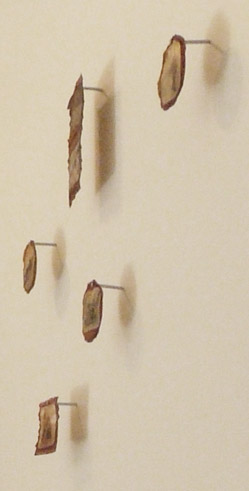
Warm Memories, 2008, photographic emulsion on teabags held by magnets, by Martje Zandboer, The Hague , The Netherlands
The stains and irregularities lend a nostalgic warmth to a story mixed with suffering and change. Martje grew up hearing these bittersweet stories of her grandmother’s time in prison, followed by being forced to leave the land she was raised in.
Each teabag is suspended in space, held by a magnet. A reminder of the affects of the chances and changes of culture and times we are born into.
Martje Zandboer, a graduate of the Hague Royal Academy of Fine Arts (2005), with a Master’s in photography from Falmouth University, Cornwall, U.K. (2008), lives in The Hague, The Netherlands. Since 2006 she has taught art courses for adults and children for the city public art museum (Gemeente Museum) and the Mesdag Museum in the Hague as well as sandstone and ice sculpting for other Hague museums. Recent exhibitions are “Drawing a family around Me” at Galerie It Frysk Skildershûs in Leeuwarden (2010), The Netherlands; Eigenwijs weimar in Atelier Paul v/d Donk (2012), The Hague, and the International competition for young photographers Sotiri 2011 with her series “Intimate Propaganda: Family photographs” in Galleria ‘Guri Madhi’, Albania. Her art practice varies from the pedagogical to painting and drawing, to experimental photographic work.
Watch this space for blogs on the works by 13 New Zealand and Hague Based artists in The Poetic Condition show until 10 Dec 2017 at the BackWal Gallery, 99 Atkinson Ave, Otaki. 12 Nov blog | Exhibition info
]]>
